EU researchers have made big steps towards the creation of a fully functional robotic nose
The BIOMACHINELEARNING project has created a neuromorphic network for odour recognition, running on actual neuromorphic hardware that will be able to receive real-time input from electrical gas sensors. This is an important step towards the creation of a cost-effective, portable and fully functional robotic nose that could be utilised in a number of different sectors, from agriculture (e.g. Monitoring fruit ripeness), medicine (e.g. Diagnosing various diseases) or personal lifestyle (e.g. Ascertaining the name of a particular perfume smelled randomly during the morning commute). An unexpected discovery One of the key challenges in being able to develop this technology is to improve the accuracy and speed of odour detection and identification in electronic nose systems. When investigating how to do this through an analysis of data from electronic gas sensors, the project team made an unexpected discovery. Using bio-inspired signal processing, they were able to enhance the signals from the sensors to a level high enough to resolve variations in gas concentrations that are due to a phenomenon called ‘turbulence’. ‘Turbulence is a ubiquitous phenomenon in gas sensing, and there’s actually quite a lot of information encoded in turbulence-induced variations of gas concentration,’ explained principal researcher Dr Michael Schmuker. ‘For example, if we’re close to a gas source, these turbulence-induced changes occur on very rapid timescales. Further away, the changes are less drastic and much slower. This is a well-established fact that has been known for decades, but it was commonly assumed that sophisticated, fast sensors are required to resolve these small differences.’ Instead, the team discovered that such rapid concentration changes can be resolved with cheap, off-the-shelf gas sensors and appropriate signal processing. ‘This was indeed a game changer that paves the way for some very interesting applications,’ commented Dr Schmuker. A bio-inspired solution for odour detection and classification Armed with this new knowledge, Dr Schmuker and his colleagues have worked towards realising a bio-inspired solution for fast and accurate odour detection and classification. The project’s method to enhance the signal of gas sensors is closely inspired by the way neurons work. Neurons respond most to rapid changes in their synaptic input, meaning they can adapt easily. ‘The signal processing method we devised operates pretty much like an adapting neuron,’ Dr Schmuker said. Neurons exchange their information through short pulses of activity called ‘spikes’ which is potentially a lot more efficient than continuously exchanging numbers, as a conventional computer would do. The project is using specialised neuromorphic hardware (silicon chips that harbour hundreds or thousands of electronic neurons) to accelerate spiking computation and model brain circuits in a very detailed fashion whilst maintaining computational efficiency. The odour classification network is closely inspired how insect brains mediate the sense of smell. The input data (sensor readings) are encoded by ‘virtual olfactory receptors’ and then processed by a network that is closely modelled after a component of the insect olfactory system, the antennal lobe. This is crucial for obtaining good odour recognition performance. Neuromorphic hardware systems The project used two neuromorphic hardware systems that are fully operational. Odour recognition networks have been successfully deployed on both platforms. ‘The efficiency of these systems lies in their massively parallel architecture,’ stated Dr Schmuker. ‘With the right network, these systems have the potential to perform as well as conventional computers in pattern recognition, but at a fraction of the energy costs.’ He also pointed out that many major global tech companies are starting to adopt this technology, indicating that neuromorphic computing is becoming an integral part of the industrial computing infrastructure. Next steps The project team are now enthusiastic to develop a physical implementation of an electronic nose coupled with neuromorphic hardware, performing odour recognition and/or gas-based navigation on a robot. ‘I think such proof-of-concept prototypes are the first step to attract potential industrial partners who may be interested in integrating our results in their product line,’ commented Dr Schmuker. Looking to the long-term, Dr Schmuker also outlined his overall vision for the technology: ‘My vision is that electronic noses will be as common as cameras and microphones... Electronic nose technology that has low power requirements and good recognition performance opens the way towards a whole new understanding of our chemical environment.’ For more information please see: project’s CORDIS webpage
Countries
United Kingdom



